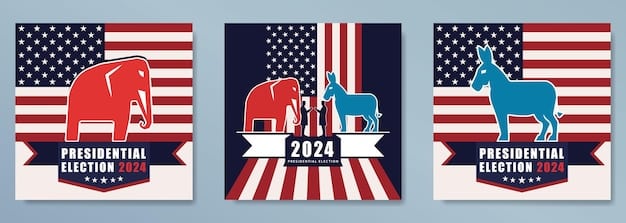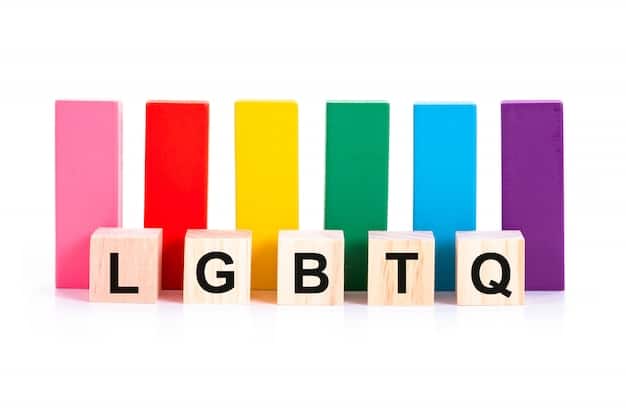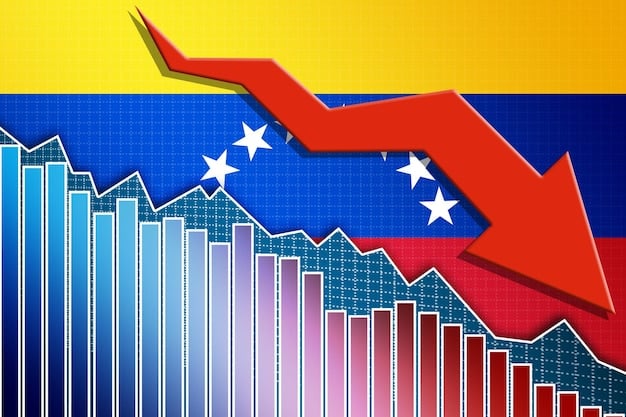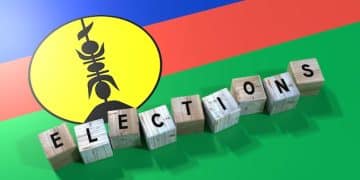Conservative vs. Liberal Policies: Key Differences Defined

Conservative and liberal approaches to public policy debates differ significantly in their core values, priorities, and proposed solutions, leading to contrasting views on issues like healthcare, taxation, and social welfare.
Understanding the key differences between conservative and liberal approaches to public policy debates is crucial for navigating the complex landscape of American politics. From healthcare to education, these ideological stances shape the very fabric of society, leading to distinct policy proposals and visions for the future. This article delves into the core tenets of each perspective, highlighting where they diverge and how these differences manifest in practical policy debates.
Understanding the Core Ideologies
Conservative and liberal ideologies form the bedrock of American political discourse. Each perspective offers a distinct framework for understanding the role of government, individual freedoms, and societal well-being. Recognizing these fundamental differences is essential for comprehending the nuances of public policy debates.
The Conservative Perspective
Conservatism emphasizes individual responsibility, limited government, and traditional values. It advocates for fiscal responsibility, a strong national defense, and a free market economy. Socially, conservatives often support traditional family structures and religious values.
The Liberal Perspective
Liberalism, on the other hand, prioritizes social justice, government intervention to address inequality, and individual rights. It supports a social safety net, environmental protection, and government regulation of the economy. Socially, liberals tend to be more accepting of diverse lifestyles and beliefs.

These core values often lead to drastically different policy proposals. While conservative might favor tax cuts to stimulate the economy, a liberal might advocate for increased government spending on social programs. Understanding these underlying principles is key to deciphering the rhetoric surrounding policy debates.
Here are some key differences in core values:
- Individual Responsibility vs. Social Responsibility: Conservatives emphasize personal accountability, while liberals prioritize the collective good.
- Limited Government vs. Government Intervention: Conservatives prefer minimal government involvement, while liberals see a role for government in addressing societal problems.
- Traditional Values vs. Social Progress: Conservatives uphold traditional norms, while liberals advocate for social change and inclusivity.
In conclusion, the fundamental differences in core ideologies between conservatives and liberals shape their approaches to public policy debates, leading to contrasting perspectives on various issues.
Economic Policy: Taxation and Regulation
Economic policy is a major battleground between conservative and liberal viewpoints. Taxation and regulation are two key areas where their approaches diverge significantly, reflecting their differing philosophies on the role of government in the economy.
Conservative Economic Policies
Conservatives generally favor lower taxes, reduced government spending, and deregulation. They believe that these policies stimulate economic growth by encouraging investment and entrepreneurship. Supply-side economics, often associated with conservative policies, argues that tax cuts for businesses and wealthy individuals will trickle down to the rest of the economy.
Liberal Economic Policies
Liberals, conversely, advocate for progressive taxation, increased government spending on social programs, and regulation of industries to protect consumers and the environment. They believe that these policies promote economic equality and social welfare. Demand-side economics, favored by liberals, suggests that government spending boosts demand and creates jobs.

The debate over taxation often revolves around the issue of income inequality. Conservatives argue that high taxes discourage wealth creation, while liberals contend that progressive taxation is necessary to redistribute wealth and fund social programs. Similarly, regulation is a point of contention, with conservatives arguing that it stifles economic growth and liberals arguing that it protects consumers and the environment from corporate excesses.
Key distinctions in economic policy include:
- Tax Cuts vs. Increased Spending: Conservatives prefer cutting taxes to stimulate the economy, while liberals favor increased government spending on social programs.
- Deregulation vs. Regulation: Conservatives advocate for reduced regulation, while liberals support government oversight to protect consumers and the environment.
- Free Market vs. Government Intervention: Conservatives believe in the efficiency of the free market, while liberals see a role for government in correcting market failures.
In conclusion, the contrasting approaches of conservatives and liberals to taxation and regulation reflect their fundamental differences in economic philosophy, with conservatives prioritizing economic growth and liberals emphasizing economic equality and social welfare.
Social Issues: Abortion, LGBTQ+ Rights, and Religion
Social issues often spark the most passionate and divisive debates between conservatives and liberals. Topics like abortion, LGBTQ+ rights, and the role of religion in public life highlight the fundamental differences in their values and beliefs.
Conservative Views on Social Issues
Conservatives generally hold more traditional views on social issues, often rooted in religious or moral beliefs. They tend to oppose abortion, support traditional marriage, and advocate for religious freedom in the public square. They emphasize the importance of traditional family structures and values.
Liberal Views on Social Issues
Liberals, conversely, champion individual rights, social justice, and inclusivity. They support abortion rights, LGBTQ+ rights, and a separation of church and state. They advocate for tolerance and acceptance of diverse lifestyles and beliefs.
The debate over abortion rights is a prime example of this divide. Conservatives often argue for the protection of unborn life, while liberals emphasize a woman’s right to choose. Similarly, the issue of LGBTQ+ rights has seen significant polarization, with conservatives often focusing on traditional definitions of marriage and liberals advocating for equal rights and recognition for LGBTQ+ individuals.
Here’s a summarized view:
- Abortion: Conservatives generally oppose abortion, while liberals support abortion rights.
- LGBTQ+ Rights: Conservatives often support traditional marriage, while liberals advocate for equal rights for LGBTQ+ individuals.
- Religion: Conservatives tend to favor a greater role for religion in public life, while liberals advocate for a strict separation of church and state.
In essence, the contrasting views of conservatives and liberals on social issues reflect their fundamental differences in values, with conservatives emphasizing tradition and morality and liberals prioritizing individual rights and social justice.
Healthcare Policy: Access and Affordability
Healthcare is a critical policy area where conservative and liberal approaches clash, particularly when it comes to access and affordability. Their differing views on the role of government in healthcare lead to distinct policy proposals aimed at addressing the challenges facing the US healthcare system.
Conservative Healthcare Policies
Conservatives generally favor market-based approaches to healthcare, emphasizing individual responsibility and competition among providers. They advocate for policies such as tax credits for health insurance, deregulation of the healthcare industry, and consumer-directed health plans. They believe that these policies will lower costs, increase access, and improve the quality of care.
Liberal Healthcare Policies
Liberals, on the other hand, support government intervention to ensure universal access to affordable healthcare. They advocate for policies such as expanding Medicaid, strengthening the Affordable Care Act (ACA), and even implementing a single-payer healthcare system. They believe that healthcare is a right, not a privilege, and that government has a responsibility to ensure that everyone has access to quality care.
The Affordable Care Act (ACA), also known as Obamacare, exemplifies the liberal approach to healthcare. It expanded health insurance coverage to millions of Americans through subsidies and regulations. Conservatives have consistently opposed the ACA, arguing that it is too costly, inefficient, and infringes on individual liberty.
The main differences are:
- Market-Based vs. Government Intervention: Conservatives favor market-based approaches, while liberals support government intervention to ensure access to affordable healthcare.
- Individual Responsibility vs. Universal Access: Conservatives emphasize individual responsibility for healthcare, while liberals believe that healthcare is a right.
- Tax Credits vs. Government Subsidies: Conservatives advocate for tax credits for health insurance, while liberals support government subsidies to expand coverage.
In summary, the contrasting approaches of conservatives and liberals to healthcare policy reflect their differing philosophies on the role of government, with conservatives prioritizing individual choice and market efficiency and liberals emphasizing universal access and social equity.
Education Policy: School Choice and Standards
Education policy is another key area where conservative and liberal approaches diverge, particularly when it comes to school choice and academic standards. Their differing views on the role of government in education lead to distinct policy proposals aimed at improving student outcomes and ensuring equal opportunity.
Conservative Education Policies
Conservatives generally favor school choice policies, such as vouchers and charter schools, which allow parents to choose the schools their children attend. They believe that competition among schools will improve quality and that parents should have the right to choose the best educational option for their children. They also tend to support standardized testing and accountability measures to ensure that schools are meeting academic standards.
Liberal Education Policies
Liberals, conversely, tend to support public education and advocate for increased funding for traditional public schools. They are often skeptical of school choice policies, arguing that they drain resources from public schools and exacerbate inequality. They emphasize the importance of teacher quality, smaller class sizes, and equitable funding for all schools.
The debate over Common Core State Standards is a prime example of this divide. Conservatives initially supported Common Core as a way to raise academic standards, but many have since turned against it, arguing that it is a federal overreach and that it undermines local control of education. Liberals generally support Common Core, arguing that it provides a common set of standards for all students and helps to ensure that they are prepared for college and careers.
Points to remember:
- School Choice vs. Public Education: Conservatives favor school choice policies, while liberals support public education and increased funding for public schools.
- Competition vs. Equity: Conservatives believe that competition among schools will improve quality, while liberals emphasize the importance of equitable funding for all schools.
- Standardized Testing vs. Comprehensive Assessment: Conservatives support standardized testing, while liberals advocate for a more comprehensive approach to assessment that includes multiple measures of student learning.
In brief, the contrasting approaches of conservatives and liberals to education policy reflect their differing philosophies on the role of government, with conservatives prioritizing choice and competition and liberals emphasizing equity and access.
Environmental Policy: Regulation and Conservation
Environmental policy is another significant area of disagreement between conservatives and liberals. Their differing views on the role of government in protecting the environment lead to distinct policy proposals aimed at addressing climate change, pollution, and resource management.
Conservative Environmental Policies
Conservatives generally favor market-based approaches to environmental protection, such as voluntary conservation efforts and incentives for businesses to reduce pollution. They are often skeptical of government regulation, arguing that it stifles economic growth and infringes on individual property rights. They tend to prioritize economic development over environmental protection.
Liberal Environmental Policies
Liberals, on the other hand, support government regulation to protect the environment and address climate change. They advocate for policies such as the Clean Air Act, the Clean Water Act, and investments in renewable energy. They believe that government has a responsibility to protect the environment for future generations.
The debate over climate change is a prime example of this divide. Conservatives often question the scientific consensus on climate change and oppose policies to reduce greenhouse gas emissions, arguing that they will harm the economy. Liberals, in contrast, view climate change as a serious threat and support policies such as the Paris Agreement and carbon pricing mechanisms to reduce emissions.
Key distinctions are listed below:
- Market-Based vs. Government Regulation: Conservatives favor market-based approaches, while liberals support government regulation to protect the environment.
- Economic Development vs. Environmental Protection: Conservatives tend to prioritize economic development, while liberals emphasize the importance of environmental protection.
- Voluntary Conservation vs. Mandated Standards: Conservatives advocate for voluntary conservation efforts, while liberals support mandated standards for pollution and resource management.
In closing, the contrasting approaches of conservatives and liberals to environmental policy reflect their differing philosophies on the role of government, with conservatives prioritizing economic freedom and individual property rights and liberals emphasizing environmental stewardship and sustainability.
| Key Concept | Brief Description |
|---|---|
| ⚖️ Role of Government | Conservatives favor limited government; liberals advocate for government intervention to address societal issues. |
| 💰 Economic Policy | Conservatives prefer lower taxes and deregulation; liberals support progressive taxation and government regulation. |
| ❤️ Social Issues | Conservatives hold traditional views; liberals champion individual rights and social justice. |
| 🌱 Environment | Conservatives favor market-based solutions; liberals support government regulation for environmental protection. |
Frequently Asked Questions (FAQ)
▼
At their core, conservatives prioritize individual responsibility and limited government, while liberals value social justice and government intervention to address inequality and promote the common good.
▼
Conservatives favor lower taxes, deregulation, and free market policies, while liberals support progressive taxation, government regulation, and social safety nets for economic equality.
▼
Conservatives generally hold traditional views, often rooted in religious beliefs, while liberals champion individual rights, social justice, and inclusivity towards all people.
▼
Conservatives advocate for market-based healthcare solutions, emphasizing individual responsibility. Liberals support government intervention for universal access and affordable healthcare for everyone.
▼
Conservatives often favor market-based solutions while liberals support strong government regulations and policies to address the global crisis that is climate change for future generations.
Conclusion
In conclusion, the distinctions between conservative and liberal approaches to public policy debates are deeply rooted in their core values, priorities, and proposed solutions. Recognizing these differences is essential for understanding the complexities of American politics and engaging in informed discussions about the future of public policy. From economic policy to social issues, healthcare to environmental protection, the contrasting perspectives of conservatives and liberals shape the debates that define the nation’s trajectory.





